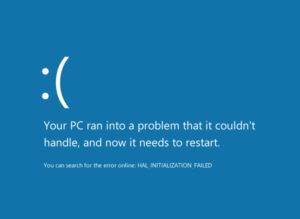Experiencing the ‘Blue Screen of Death’ is a rite of passage for any Microsoft user (even Bill Gates himself). We’ve all been there, staring blankly at a complicated error code we don’t understand and can’t write down fast enough before the computer reboots.
But, with the introduction of Windows Server 2012, the dreaded Blue Screen of Death (BSoD) changed. The difference is easy to spot (and it’s not just that the arresting navy blue background has become a gentle cerulean).

Windows 7 BSoD

If you’re wondering what this has got to do with copywriting, here’s the rub: it’s all about voice and tone.
Not ‘tone of voice’ — that’s too singular. It’s more useful to separate it into ‘voice’ and ‘tone’. A company shouldn’t have one tone of voice that applies to everything they write; there needs to be a single voice, but a different tone for every occasion. And therein lies the problem with the new BSoD.
Voice and tone can both be expressed in a variety of ways – here are a few:
- Your vocabulary — what kind of language do you always use, and which words should your brand never use?
- Sentence length and structure — are all your sentences short and snappy? Or are you a fan of a subordinate clause (or two)?
- Punctuation — does your brand use en-dashes? Semi-colons? Exclamation points (if you really must)?
Voice and tone: what’s the difference?
So what’s the difference between voice and tone, if they’re expressed in the same ways?
Your voice is about you. It’s your brand’s unique personality, the traits that define how you present yourself to your customers. It’s about whether you’re conversational and friendly, or formal and reserved. And it’s about the little things, like whether you use contractions or not. This doesn’t change, whether you’re sending out a tweet, a press release, or a massive ebook.
Your tone, however, isn’t about you. It’s about your customer and their context — why are they interacting with you? Are they looking to buy, for after-sales support, or to register a complaint? The tone you use with your customers needs to be appropriate for the circumstances.
The Blue Screen of Tone-Deaf
With that in mind, let’s take another look at the – ahem – rebooted blue screen of death. The frankly intimidating ream of technical information has been pared down to the vital components (and a sad face).
On the one hand, this is a great idea — cutting through the noise to offer your average user a simplified screen and a code that’s easy to search later. From a copywriting perspective, it’s the ideal way to convey the (error) message, with concise, jargon-free text: something’s gone wrong, and your PC is going to restart.
But on the other hand, the user is experiencing a sudden, unavoidable failure of their computer, and is probably busy swearing and hoping their files are all where they should be if/when their PC reboots. At that moment, when the urge to throw the computer out of a window is at its strongest, this error message is more than a little, well, tone-deaf.
To a user who may just have lost a couple of hours of work, or been cut off during a vital video call, a sad emoticon isn’t cutesy — it’s adding yet another layer of frustration. The wording of the message itself is vague, and too relaxed; ‘couldn’t handle’ doesn’t really tell us anything — is this a temporary glitch? Or is my PC melting on the inside?
It’s not just the blue screen of death that makes this tonal gaffe; there’s also this from Google Chrome:

While you’re just browsing the internet, that ‘Aw, Snap!’ might not trouble you too much. But imagine it turning up when you’re trying to pay a credit card bill, or book a last-minute flight, or buy Glastonbury tickets. That sad-faced dead tab is a lot less cute when your transaction is stuck in broken-webpage limbo. (This is also true of websites that have ‘oops!’ in their error pages — being flippant is a dangerous path to tread when things are going wrong for your customers.)
It’s not limited to the internet, either — how many times have you been cheerfully informed that “your call is important to us” or received an ill-timed, chipper sales pitch while you were stewing in your third hour on hold to your gas supplier or your mobile company?
In each case, the disconnect comes from companies trying to stick too closely to their brand voice, whatever the situation, without considering the customer’s experience.
And this happens both ways — a formal brand with a particularly stuffy Twitter account can be equally as off-putting as a brand that’s trying too hard to be your friend; a company that’s too casual with their response to a fault report can alienate a customer, but responding with a barrage of dry legalese can be just as bad.
Match your tone to your customer’s context
As writers, we’re constantly making choices in our copy. They’re often small, but always significant, about things like the right analogy to use, or where exactly to place the semi-colon, or which facts are the most interesting. And we make those decisions based on the audience we’re writing for; that one person we really want our copy to resonate with.
The voice and tone should inform all these decisions, too.
It can be a delicate balancing act, staying true to your voice in different contexts, but there are some really simple questions to ask yourself to make sure you’re getting it right:
- Where is my customer reading this? The format should influence your tone — a Facebook post will likely differ from your terms and conditions.
- What’s their mood likely to be? Don’t risk making an unhappy customer unhappier with an ill-timed joke, or killing their celebratory mood with a grim legal disclaimer.
- If I read this as a customer, would it feel natural? Or, “if I read this as a customer, would I find it friendly/annoying/too formal?”
If you’ve done that and you’re still not quite sure, here’s a word to the wise: stay away from the emoticons, just in case.
😉
Windows 7 BSOD image by Zacchi4k is used under a Creative Commons Attribution-Share Alike 4.0 International license.
Aw, Snap: Chrome bonks image by Bradley Dilger is used under a Creative Commons Attribution-ShareAlike 2.0 license.


